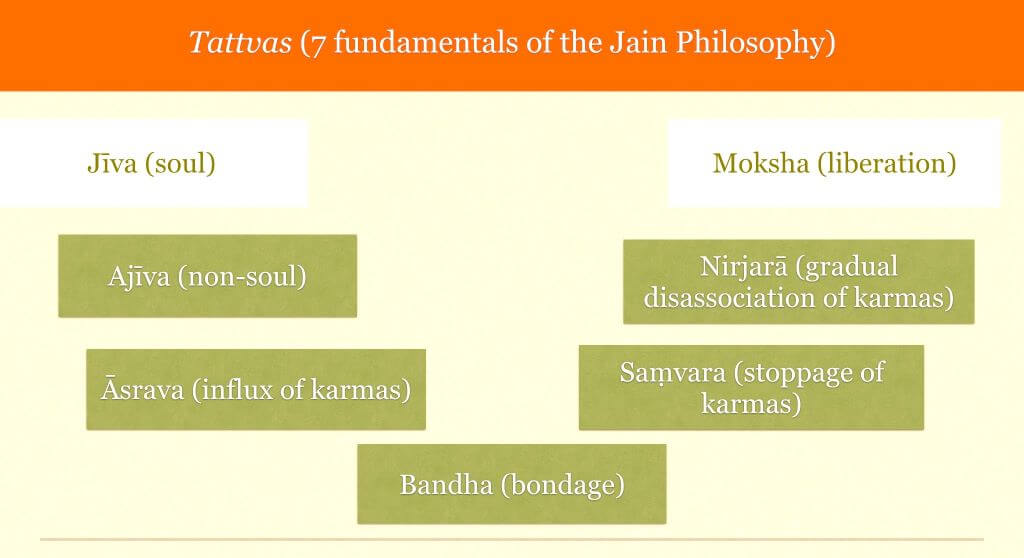Jainism, one of the world’s oldest religions, is deeply rooted in the principles of non-violence, truth, and self-realization. Emerging in ancient India around the 6th century BCE, Jainism is not just a faith but a way of life that emphasizes purity of thought, speech, and action. At its heart lies the path to liberation (moksha)—freedom from the endless cycle of birth and death (samsara).
To achieve liberation, Jain philosophy identifies seven fundamental principles, also called the Tattvas. These principles explain the nature of the soul, karma, bondage, and the path to ultimate liberation. They serve as the foundation of Jain ethics, spirituality, and worldview. Understanding these seven principles is crucial for anyone seeking to grasp the essence of Jainism.
In this blog, we will explore each of these principles in depth, their philosophical significance, and how they shape the Jain way of life.
The Seven Fundamental Principles of Jainism (Tattvas)
The seven principles of Jainism are:
- Jiva (Soul)
- Ajiva (Non-soul)
- Asrava (Influx of Karma)
- Bandha (Bondage of Karma)
- Samvara (Stoppage of Karma)
- Nirjara (Shedding of Karma)
- Moksha (Liberation)
These tattvas explain the soul’s journey—how it gets entangled in worldly attachments and karma, and how it can ultimately achieve liberation through spiritual discipline. Let’s examine each in detail.
Jiva (Soul)
In Jainism, the soul (jiva) is considered eternal, conscious, and full of potential for infinite bliss and knowledge. Every living being, whether human, animal, insect, plant, or microorganism, possesses a soul.
Key Features of Jiva:
- Souls are inherently pure, but their purity is obscured by karma.
- Each soul is individual and distinct; no two souls are the same.
- A soul is characterized by consciousness (chetana) and knowledge (gyana).
The soul’s true nature is infinite knowledge, infinite bliss, infinite energy, and infinite perception. However, due to karmic bondage, it cannot realize its full potential.
Jains believe that recognizing the existence of the soul is the first step toward liberation. When one understands that the body is temporary but the soul is eternal, detachment from worldly pleasures becomes easier.
Ajiva (Non-soul)
While jiva represents the conscious element, ajiva refers to the non-living, non-conscious substances of the universe. Jain philosophy classifies the world into living (jiva) and non-living (ajiva) entities.
Categories of Ajiva:
- Pudgala (Matter) – All physical substances, including atoms, water, fire, and bodies.
- Dharma (Medium of Motion) – The principle that enables movement.
- Adharma (Medium of Rest) – The principle that allows rest and stability.
- Akasha (Space) – Provides room for all substances to exist.
- Kala (Time) – Helps in measuring change and events.
Ajiva forms the environment in which souls exist and act. Interaction between jiva and ajiva results in karmic bondage, which keeps the soul trapped in the cycle of birth and death.
Asrava (Influx of Karma)
The third principle, asrava, refers to the inflow of karmic matter into the soul. Karma in Jainism is not metaphorical but a real, subtle form of matter that binds to the soul due to actions, thoughts, and speech.
Causes of Asrava:
- Violence (Himsa) – Harming living beings.
- Falsehood (Asatya) – Speaking lies or deceiving others.
- Stealing (Adattadana) – Taking what is not rightfully yours.
- Unchastity (Maithuna) – Indulgence in sensual pleasures.
- Possessiveness (Parigraha) – Attachment to material wealth.
Asrava occurs through the activities of body, mind, and speech when accompanied by passions like anger, pride, deceit, and greed. It is the entry point of karmic bondage and must be controlled.
Bandha (Bondage of Karma)
Once karma enters the soul, it results in bandha—the bondage of the soul with karmic particles. This bondage determines the soul’s experiences of pleasure and pain, birth and death, and the cycle of reincarnation.
Types of Bandha:
- Nature Bondage (Prakriti Bandha) – Determines the type of karma (knowledge-obscuring, perception-obscuring, deluding, obstructive, etc.).
- Duration Bondage (Sthiti Bandha) – The length of time karma will remain attached.
- Intensity Bondage (Anubhava Bandha) – The strength of karmic results.
- Quantity Bondage (Pradesha Bandha) – The extent of karmic particles bound to the soul.
Bandha explains why each soul’s journey is unique—our karmas shape our present and future lives. Liberation is possible only by breaking this bondage.
Samvara (Stoppage of Karma)
Samvara is the process of stopping new karmic particles from attaching to the soul. It is like closing the door to prevent further dust from entering a room.
How to Achieve Samvara:
- Right Faith (Samyak Darshan) – Believing in the truth of Jain philosophy.
- Right Knowledge (Samyak Gyan) – Understanding reality without distortion.
- Right Conduct (Samyak Charitra) – Living a life of non-violence, honesty, purity, and detachment.
- Practicing Austerities (Tapas) – Self-discipline and penance.
- Observing the Five Vows (Mahavratas for monks, Anuvratas for laypeople):
- Non-violence (Ahimsa)
- Truth (Satya)
- Non-stealing (Asteya)
- Chastity (Brahmacharya)
- Non-possessiveness (Aparigraha)
By following samvara, the soul prevents fresh karmic influx and moves closer to purification.
Nirjara (Shedding of Karma)
While samvara stops new karmic inflow, nirjara is the process of destroying or shedding the karmas already attached to the soul. This purification is essential for ultimate liberation.
Two Types of Nirjara:
- Passive Nirjara (Akama Nirjara) – Natural exhaustion of karmas over time.
- Active Nirjara (Sakama Nirjara) – Conscious efforts through austerities and spiritual practices.
Practices for Nirjara:
- External Austerities: Fasting, dietary restrictions, giving up comforts, solitude, and self-discipline.
- Internal Austerities: Repentance, humility, service, meditation, self-study, and detachment.
Through nirjara, the soul gradually becomes free from karmic impurities, revealing its true divine nature.
Moksha (Liberation)
The ultimate goal of Jainism is moksha, liberation from the cycle of birth and death. A liberated soul is free from all karmic matter, existing in its pure state of infinite bliss, knowledge, and energy.
Path to Moksha:
- Following the Three Jewels (Ratnatraya):
- Right Faith (Samyak Darshan)
- Right Knowledge (Samyak Gyan)
- Right Conduct (Samyak Charitra)
When the soul completely sheds karmic bondage through nirjara and prevents new influx through samvara, it rises to the top of the universe (Siddhashila), where liberated souls reside eternally.
Moksha is not just an escape from suffering but the realization of the soul’s inherent perfection.
Significance of the Seven Principles in Daily Life
Although the tattvas are philosophical concepts, they also have practical applications in daily life. By understanding them, Jains cultivate ethical living, spiritual growth, and compassion for all beings.
- Awareness of Jiva encourages respect for all life forms, leading to non-violence.
- Understanding Ajiva highlights detachment from material possessions.
- Recognizing Asrava and Bandha makes one mindful of their actions and consequences.
- Practicing Samvara and Nirjara helps in spiritual purification.
- Striving for Moksha gives life a higher purpose beyond worldly attachments.
Conclusion
The seven fundamental principles of Jainism form the spiritual foundation of the faith. They explain the soul’s journey from bondage to liberation, emphasizing self-discipline, non-violence, and detachment.
For Jains, these principles are not just abstract theories but guiding lights for daily conduct. They remind us that liberation is attainable through conscious effort—by curbing desires, shedding karmas, and realizing the eternal soul.
Ultimately, Jainism teaches that each soul is responsible for its own destiny. By understanding and practicing these seven tattvas, one can progress toward the highest goal: moksha, the state of eternal bliss and freedom.
FAQs on the 7 Fundamental Principles of Jainism
The seven principles, also known as tattvas, are: Jiva (soul), Ajiva (non-soul), Asrava (influx of karma), Bandha (bondage of karma), Samvara (stoppage of karma), Nirjara (shedding of karma), and Moksha (liberation). They form the foundation of Jain philosophy.
They explain the journey of the soul, how it gets bound by karma, and the process to achieve liberation. By practicing these principles, Jains cultivate non-violence, self-discipline, and detachment, ultimately leading to spiritual freedom.
Jiva refers to the living, conscious soul that has knowledge and perception. Ajiva refers to non-living, non-conscious substances such as matter, space, time, motion, and rest. Together, they make up the universe.
In Jainism, karma is a fine form of matter that attaches to the soul due to actions, thoughts, and speech influenced by passions. This karmic bondage determines rebirths, experiences, and suffering. Liberation comes by stopping the influx (Samvara) and shedding karma (Nirjara).
The Three Jewels—Right Faith, Right Knowledge, and Right Conduct—are essential for achieving Samvara and Nirjara. They act as practical tools for applying the seven principles in daily life and are necessary for attaining moksha.
Both monks and laypeople can practice the tattvas, though to different extents. Monks follow stricter vows (Mahavratas), while laypeople observe smaller vows (Anuvratas). The principles are universal and meant for everyone who seeks spiritual progress.
Moksha is the ultimate liberation of the soul from all karmic bondage and the cycle of birth and death. A liberated soul exists in Siddhashila, the highest realm, in a state of eternal bliss, knowledge, and freedom.
Samvara can be practiced through right faith, right knowledge, self-discipline, non-violence, and ethical conduct. Nirjara involves austerities such as fasting, meditation, repentance, and self-study, helping reduce existing karmic load.






